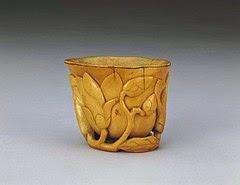
Ivory Carving | Palace Museum Collection
History of Chinese Ivory From Paleolithic to Qing
Hunters and fishers of Paleolithic age already learned to make use of the inedible parts of their game and work these into simple tools or ornaments. Ivory went on to become an integrated and widely used component of Neolithic craft cultures, often made into items of ritual and religious purposes. Following on the spread and advancement of civilization, however, the elephants and rhinoceroses which used to roam over China Proper in remote antiquity retreated from basins of the Yellow River and the Yangtze River.
Bronze was the crux of the Shang culture (1600-1046 B.C.E.) but significant progress in ivory carving also appeared at the time. The Shang craftsmen not only worked the intrinsic nature of the material, they also enhanced its beauty with semi-precious stone inlay such as turquoise. Fast forward into Yuan Dynasty (1271-1368), the royal house often decorated their palaces with ivory, thus leaving little for other private use outside the court. Lack of materials led to the decline of the art. Ivory carving went downhill as a result.
To Read More CLICK HERE~!
Leave a Reply